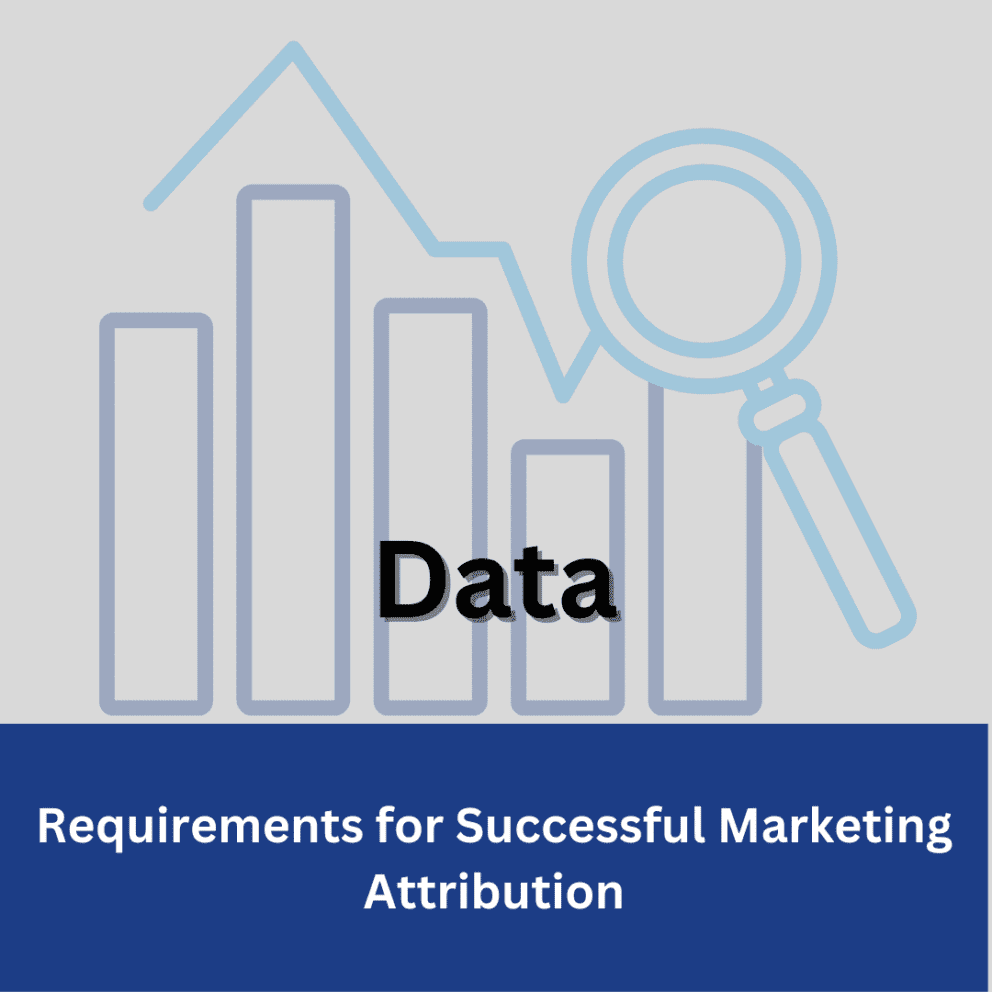Decoding the Customer Journey: A Guide to Effective Marketing Attribution – Pt. 2

Summary
Marketing attribution serves as the compass, guiding marketers through the complex landscape of touchpoints. This method allows businesses to dissect and assign value to various interactions, aiding in the optimization of campaigns and strategic resource allocation. As the second installment of this marketing attribution mini-series, this blog post will focus on how to build and implement your attribution model - from defining your objectives and choosing the right model methodology to gathering your data, building the model itself and testing its validity.
By Carly Bauer, Marketing Consultant at Heinz Marketing
In the first part of this three-part series, I talked about the basics of marketing attribution and its ability to provide insights into the customer journey. It included the different components of marketing attribution, the different types of attribution models and how to determine the most ideal model for specific situations. In part two, I’m diving into how to build and implement your attribution model. So, if you need to catch up and refresh a little, I recommend reading part one first, here.
As a higher-level recap, marketing attribution serves as a compass that helps guide marketers through the complex landscape of touchpoints. It allows businesses to dissect and assign value to various interactions, aiding in the optimization of campaigns and strategic resource allocation.
When building and implementing an attribution model it involves several steps, from defining your objects to choosing the right methodology and analyzing the results. Here’s a general guide to help you through the process.
Define Your Objectives
Before you can get started it’s important you understand your goals. Determine what you want to achieve with your attribution model. Are you looking to optimize marketing spend, understand customer journeys, or improve campaign effectiveness?
Decide what key metrics (KPIs) are most important for your business, such as engagement rate through different channels, conversion rate, customer acquisition cost (CAC), or lifetime value (LTV). It’s essential to select KPIs that align with your business objectives and provide actionable insights for decision-making. Additionally, KPIs should be regularly monitored and adjusted as needed to reflect changes in the business environment.
REMEMBER: Knowing what your end goal is and what metrics are going to help you measure and achieve it will influence what attribution model is going to work best for you.
Choose an Attribution Model Methodology
The choice between single-touch and multi-touch attribution depends on the specific needs and objectives of your business. Single-touch attribution models are ideal for companies wanting to identify entry points in the customer journey, determining closing touchpoints for conversions, and evaluating the impact of specific campaigns or initiatives. Whereas, multi-touch models help companies understand more complex customer journeys, optimize marketing mix and budget allocation, and enhance personalization and customer experiences. Each model has its own advantages and disadvantages, here are a few for both methodologies.
Single-Touch Attribution
Pros
- Simplicity – it’s straightforward and easy to implement, assigning credit to a single touchpoint, such as the first or last interaction of the customer journey.
- Clear Accountability – It’s easy to see which touchpoint gets credit for the conversions, making it easier to attribute results and allocate resources accordingly.
- Focus on Key Touchpoints – By emphasizing specific touchpoints, like the first or last interaction, this highlights key entry or exit points in the customer journey you should focus on when building your marketing strategies.
Cons
- Oversimplification: Single-touch models ignore the contribution of other touchpoints in the customer journey, potentially leading to an incomplete understanding of the customer’s path to conversion.
- Misattribution: As part of the oversimplification of a single-touch model, assigning all credit to a single touchpoint may not accurately reflect the influence of other marketing channels or touchpoints that contributed to the conversion.
- Limited Insights: Single-touch models provide limited insights into the holistic customer journey, making it challenging to optimize marketing strategies across multiple channels.
Multi-Touch Attribution
Pros
- Comprehensive View: Multi-touch models consider the entire customer journey and allocate credit across multiple touchpoints, providing a more holistic view of the customer’s interactions with the brand.
- Better Allocation of Resources: By accounting for the contribution of multiple touchpoints, multi-touch models help businesses allocate resources more effectively across various marketing channels.
- Insights into Customer Behavior: Multi-touch models reveal valuable insights into customer behavior, including the sequence of touchpoints that lead to conversion and the effectiveness of different marketing channels throughout the journey.
Cons
- Complexity: Multi-touch models are more complex to implement and analyze compared to single-touch models, requiring more advanced methodologies and sophisticated data analysis techniques.
- Data Challenges: Gathering and integrating data from multiple sources can be challenging, especially when dealing with cross-channel interactions and offline touchpoints.
- Subjectivity: Multi-touch attribution involves subjective decisions about how to weight and assign credit to different touchpoints, which can introduce biases and inconsistencies.
Gathering and Integrating Your Data
Gathering data, and the process around data collection and integration are crucial steps in building an attribution model. To start, identify what various sources you want and should collect data from, including website analytics, advertising platforms, CRM systems, and offline interactions. This data encompasses customer interactions across different touchpoints throughout the entire customer journey.
Next, preprocess and clean the collected data to ensure accuracy and consistency. This involves tasks such as removing duplicates, correcting errors (i.e. missing values), and standardizing data formats. Make sure that the dataset includes information like customer interactions, channel touchpoints, conversion events, and timestamps that are relevant to the attribution model you want to use. Once the data is cleaned and in a standardized format, merge the data from the different sources based on common identifiers or keys (i.e. customer IDs or transaction IDs) using data integration tools or scripts to create a single dataset for analysis.
By being able to effectively gather and integrate your data together, you’ll have the groundwork built to derive actionable insights and optimize marketing strategies based on your attribution model’s findings.
Building the Attribution Model
Once you’ve identified your goals and objectives for your company, you’ve determined what metrics you need to measure, what sources of data you need to collect and integrate together and have chosen the attribution model that best fits your objectives and data, it is then time to implement it. When implementing your attribution model, it is best to use statistical techniques or software tools to apply your attribution model to your dataset. These tools should be part of the foundational technology necessary for effective attribution. If you’re not sure what’s all included and want to compare the current state of your tech stack, here’s another post to refer to.
For simpler models like First-Touch or Last-Touch, basic statistical calculations or spreadsheet software may suffice to assign credits to each touchpoint you want to measure in the customer journey. For more complex models like Algorithmic or Machine Learning-based models, specialized software tools or programming languages like Python or R may be required. For example, if using a Linear Attribution model, you may assign equal credit to each touchpoint in the customer journey. If using an Algorithmic model, you may use machine learning algorithms to automatically learn the attribution weights based on historical data.
Once credit is assigned to the appropriate touchpoints in the customer journey and your attribution model is built, it’s important to establish a reporting structure. At the beginning you should have identified what key metrics and goals you wanted to track and measure; this is what defined what attribution model you needed to use. Now to be able to analyze and track that data you need to create a reporting dashboard and establish a reporting cadence to effectively monitor and pull insights.
When creating your dashboards and reports, customize them to visualize the attribution data in a clear and actionable format. Consider the different preferences and needs of each stakeholder involved, including marketing teams, executives, and sales representatives.
Key Marketing Insights
- Campaign Performance – impressions, clicks, conversions, conversion rate, and return on investment (ROI)
- Audience Engagement – website traffic, time spent on site, page views, bounce rate, and social media interactions
- Channel Effectiveness – channel attribution, cost per acquisition (CPA), and customer acquisition cost (CAC)
- Customer Journey Analysis – critical touchpoints and conversion paths
- ROI and Revenue Impact – revenue generated, customer lifetime value (CLV), and marketing-generated revenue
Key Executive Insights
- Performance Metrics – conversion rate, return on investment (ROI), customer acquisition cost (CAC), revenue generated, cost per acquisition (CPA)
- Channel Performance – traffic sources, channel contribution, and campaign effectiveness
- Customer Segmentation – customer demographics, customer lifetime value (CLV), and behavioral segmentation
- Trend Analysis – seasonal trends, campaign trends, and industry benchmarks
- Customer Journey Insights – conversion paths, customer engagement, and customer feedback
Key Sales Insights
- Lead Quality and Source
- Lead Engagement and Behavior – interactions with emails, website visits, content downloads, and social media engagement
- Opportunity Pipeline – the number, status, and value of opportunities at each funnel stage
- Marketing Campaign Performance – campaign reach, engagement, conversion rates, and return on investment (ROI)
- Competitive Insights and Market Trends – competitor activity, market share, customer sentiment, and industry developments.
Consider implementing tools and processes for automating data collection, integration, and analysis to streamline the reporting workflow. Marketing analytics platforms (Google Analytics, Adobe Analytics or HubSpot) or business intelligence tools (Tableau or Microsoft Power BI) can aggregate data from various sources and generate attribution reports efficiently for your teams.
Lastly, don’t forget to establish your reporting cadence by determining the frequency and timing of reporting cycles for analyzing the attribution data. You can have reports be generated daily, weekly, monthly, or on an ad-hoc basis depending on the pace of your business operations and the availability of data.
Validate and Test the Model
Over time continuously evaluate and refine the attribution model based on feedback, performance metrics, and changes in the business environment. As your business structure and goals change, regularly update the model parameters, attribution rules, and reporting methodologies to ensure its relevance and accuracy over time.
Cross-Validation
Cross-Validation is one way you can test the accuracy and reliability of your attribution model by comparing the model’s predictions to the actual outcomes.
- Start by splitting your dataset into a training set and a validation set.
- Apply the chosen attribution methodology to the training data to assign credits to each touchpoint in the customer journey.
- Apply the trained attribution model to the validation set to predict conversions and assign credits to touchpoints. Compare the predicted conversions and attribution results with the actual outcomes observed in the validation set.
- Calculate performance metrics to assess the accuracy and effectiveness of the attribution model. Common metrics for evaluation attribution models include accuracy, precision, recall, F1-score, and area under the receiver operating characteristic (ROC) curve.
- Analyze the results of the validation process and identify areas for improvement in the attribution model. Iterate on the model parameters, attribution rules, and methodologies based on feedback from the validation process to enhance its performance and accuracy.
To validate across multiple subsets of the data, try cross-validation techniques such as k-fold cross-validation or leave-one-out cross validations to validate the attribution model. This helps ensure robustness and generalization of the model’s performance across different data samples.
Lastly, consider holdout testing. This method provides an unbiased estimate of the model’s performance on unseen data. Start by setting aside a separate holdout dataset that is not used during the training or validation process. Use this hold out dataset to assess the performance of the final attribution model independently.
CONCLUSION:
As you evaluate the insights coming from your data, monitor the performance of marketing campaigns and their initiatives based on these attribution insights. Marketing strategies might need to be adjusted to optimize efforts to achieve business objectives. Continue to adjust as needed based on insights coming in through your data.
By following these steps, you can build and implement an attribution model into your regular reporting and decision-making processes that provides valuable insights and enables you to create data-driven marketing strategies and optimize resource allocation. Want some help? Reach out for a free brainstorm call.
Image by rawpixel.com on Freepik






